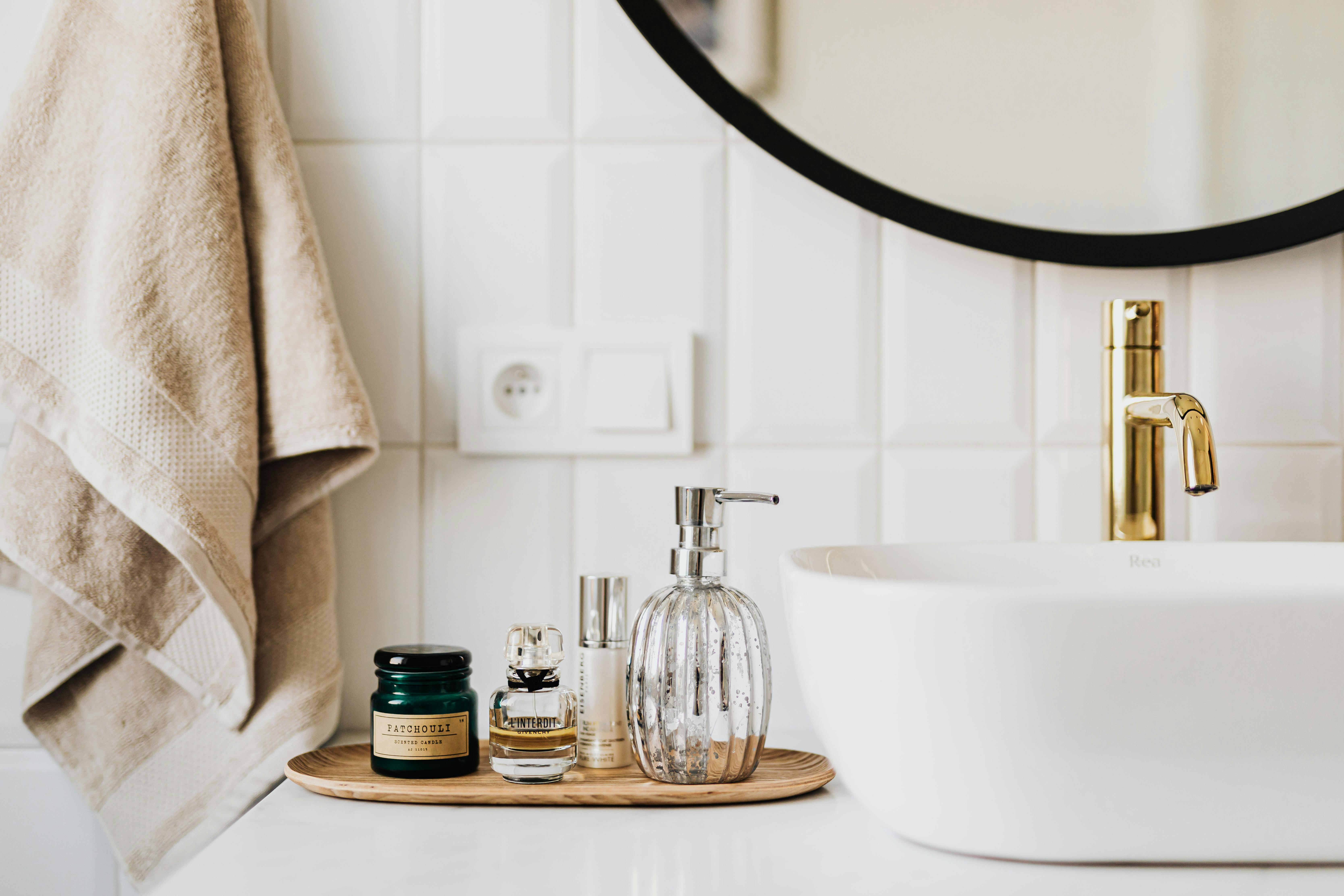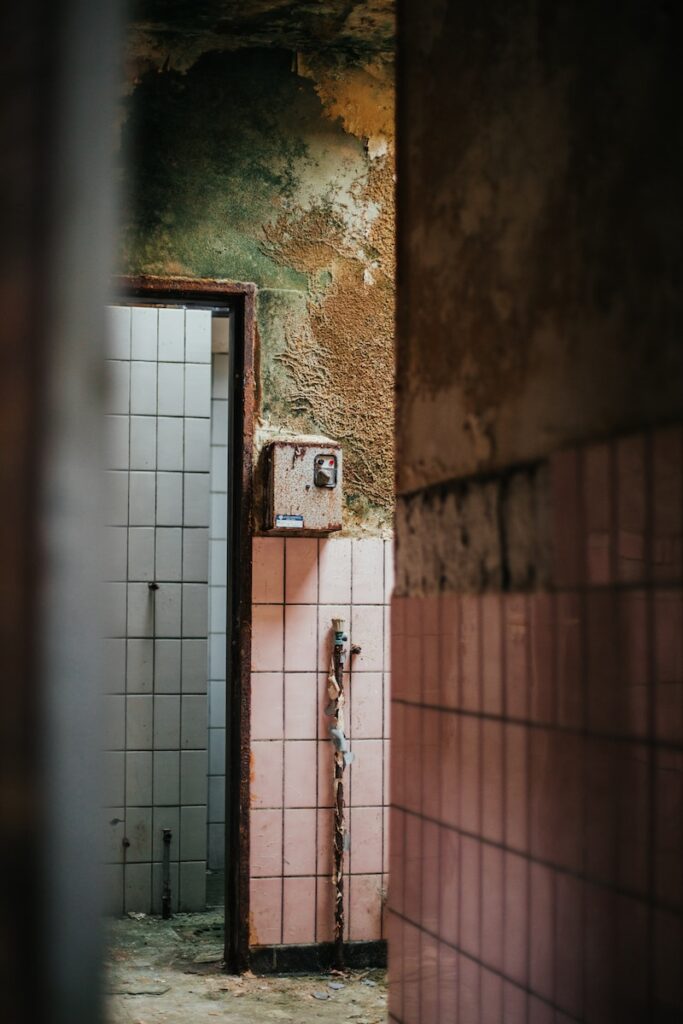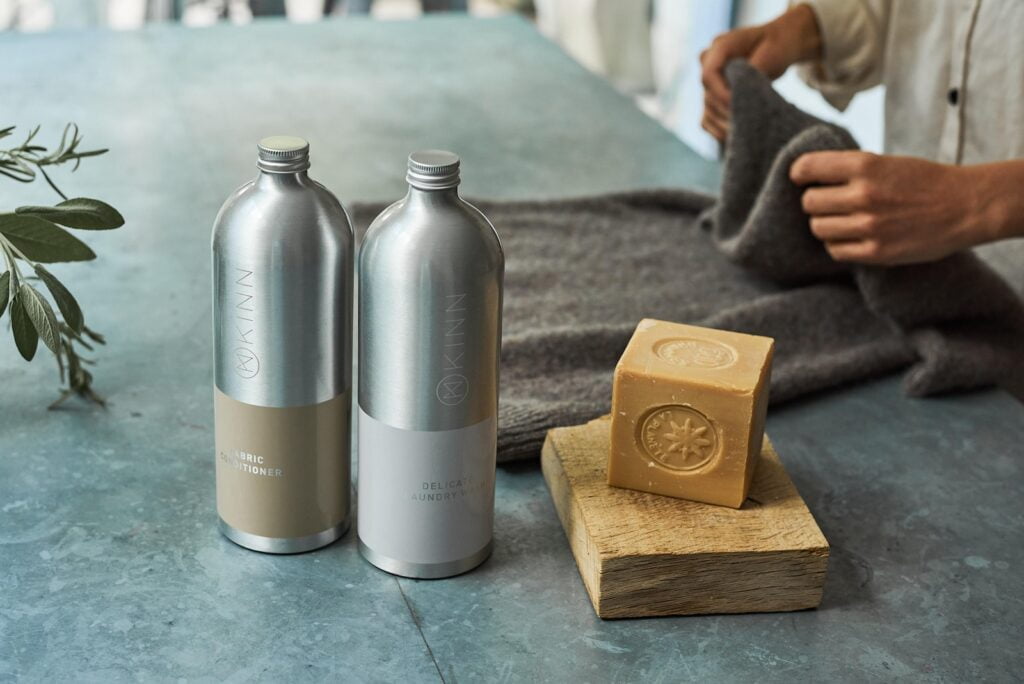So, you’ve noticed the pesky presence of mold in your bathroom, huh? Well, you’re not alone. Dealing with mold growth in bathrooms is a common issue that many homeowners face. But don’t fret, because I’ve got the scoop on how to bid farewell to that unwanted fungus. In this article, we’ll explore some effective techniques and products to help you get rid of mold in your bathroom once and for all. Say goodbye to that unsightly mold, and hello to a cleaner, healthier bathroom environment.
Identifying the Mold
Common types of mold in bathrooms
When it comes to dealing with mold in your bathroom, it’s helpful to know the common types that you might encounter. Two of the most prevalent types of mold in bathrooms are Aspergillus and Cladosporium. Aspergillus is typically black or gray and can appear powdery or speckled. Cladosporium, on the other hand, is usually green or black and can have a suede-like texture. These types of mold thrive in damp areas and can release spores into the air, potentially causing respiratory issues if inhaled.
Warning signs of mold growth
There are several warning signs that can indicate the presence of mold in your bathroom. If you notice a musty smell that persists even after cleaning, this could be a sign of mold growth. Additionally, if you see dark patches or discoloration on the walls, ceilings, or grout, it’s likely that mold is present. Peeling or bubbling paint, warped walls, or a persistent feeling of dampness are also indicators of mold growth.
Determining the severity of the mold problem
Once you’ve identified mold in your bathroom, it’s important to determine the severity of the problem. If the affected area is small, typically less than 10 square feet, you may be able to handle the cleanup yourself. However, if the mold covers a larger area or if you suspect it may be caused by underlying moisture issues, it’s best to consult a professional for a thorough assessment.
Preventing Mold Growth
Improve ventilation
Improving ventilation in your bathroom is crucial for preventing mold growth. When showering or bathing, make sure to use the exhaust fan or open a window to allow for proper air circulation. Ventilation helps to reduce excess moisture in the air, which can contribute to mold growth. Additionally, consider installing a dehumidifier in your bathroom to further control humidity levels.
Reduce moisture levels
Moisture is a primary factor in mold growth, so it’s important to take steps to reduce moisture levels in your bathroom. Wipe down surfaces, such as shower walls and countertops, after each use to remove excess water. Fix any leaking pipes or faucets promptly, as damp areas provide an ideal breeding ground for mold. Regularly check and maintain seals around fixtures, such as the shower door or bathtub, to prevent water from seeping into hidden areas.
Limit potential mold food sources
Mold requires organic matter to grow, so it’s important to limit potential food sources in your bathroom. Avoid leaving wet towels or clothing on the floor, as these can become breeding grounds for mold. Additionally, regularly clean your bathroom rugs, shower curtains, and any other fabric items to prevent the accumulation of mold-friendly materials. Keep bathroom surfaces clean and dry to discourage mold growth.
Cleaning Mold
Safety precautions before cleaning
Before you begin the process of cleaning mold in your bathroom, it’s important to take certain safety precautions. Wear protective gear, such as gloves and goggles, to minimize direct contact with mold and its spores. Open windows and doors to ensure proper ventilation while cleaning. If you have respiratory issues or are dealing with a large mold infestation, consider using a mask or respirator to protect your lungs from mold spores.
Using bleach or vinegar solution
Bleach and vinegar are two common household substances that can effectively kill mold and inhibit its growth. To create a bleach solution, mix one cup of bleach with one gallon of water. Apply the solution to the affected areas and let it sit for about 15 minutes before scrubbing. Vinegar can also be used by spraying it directly onto the moldy surfaces and letting it sit for an hour before scrubbing.
Scrubbing off mold
Once you’ve applied the cleaning solution, it’s time to scrub off the mold. Use a stiff brush or sponge to scrub the affected areas thoroughly. Pay particular attention to grout lines, caulking, and any other porous surfaces where mold can hide. Make sure to remove all visible mold and rinse the area with water to remove any residue from the cleaning solution.
Removing mold from different bathroom surfaces
Different bathroom surfaces may require specific cleaning methods to remove mold effectively. For tile and grout, use a brush with firm bristles or a toothbrush to scrub away the mold. For non-porous surfaces like glass or porcelain, a mixture of vinegar and water or a commercial mold cleaner can be used. When it comes to wood surfaces, such as cabinets or window sills, sanding or replacing the affected area may be necessary if the mold has penetrated deeply.
Natural Mold Removal Methods
Using hydrogen peroxide
Hydrogen peroxide is a natural and effective alternative to bleach for removing mold. It is readily available in most households and is safe to use. To use hydrogen peroxide, fill a spray bottle with 3% hydrogen peroxide and spray it directly onto the moldy surfaces. Let it sit for about 10 minutes to allow it to penetrate the mold, then scrub the area with a brush or sponge. Rinse the surface thoroughly with water to remove any residual mold and hydrogen peroxide.
Tea tree oil as a natural fungicide
Tea tree oil is well-known for its antifungal and antibacterial properties, making it an excellent natural fungicide for mold removal. Mix one teaspoon of tea tree oil with one cup of water in a spray bottle. Shake well to combine the ingredients and spray the solution onto the moldy surfaces. Allow it to sit for a few hours before scrubbing and rinsing the area. Keep in mind that tea tree oil has a strong scent, so proper ventilation is essential.
Baking soda and vinegar mixture
A mixture of baking soda and vinegar can also be used as a natural mold removal method. Sprinkle baking soda onto the moldy surfaces and then spray vinegar on top of it. The two ingredients will react, creating a foaming action that helps to remove mold. After the foaming subsides, scrub the area with a brush or sponge and rinse thoroughly.
Effective essential oils for mold control
Certain essential oils, such as lavender, clove, and oregano oil, have natural antifungal properties that can help with mold control. Mix a few drops of your chosen essential oil with water in a spray bottle and spray it onto the moldy surfaces. Let it sit for a few hours before scrubbing and rinsing. Not only will this method help remove mold, but it will also leave a pleasant scent in your bathroom.

Professional Mold Removal
When to call a professional
While many cases of mold in bathrooms can be effectively handled by homeowners, there are situations where it’s best to call a professional mold remediation company. If the mold covers a large area (greater than 10 square feet), if you suspect there may be underlying moisture issues or structural damage, or if you have health concerns related to mold exposure, it’s crucial to seek professional assistance. They have the expertise, equipment, and experience to handle complex mold problems safely and effectively.
Hiring a reputable mold remediation company
When hiring a mold remediation company, it’s important to do your research and choose a reputable and certified professional. Look for companies that are licensed, insured, and experienced in handling mold removal specifically. Ask for references and read reviews from previous clients. It’s also essential to ensure that the company follows industry best practices for mold remediation, including thorough containment, proper disposal of affected materials, and post-remediation verification to ensure the mold has been completely removed.
The process of professional mold removal
The process of professional mold removal typically involves several steps. First, the affected area is contained using plastic sheeting and air scrubbing equipment to prevent the spread of mold spores to other parts of the home. Next, the mold is physically removed from the surfaces using specialized tools and techniques. After the removal process, the area is thoroughly cleaned and sanitized. Finally, post-remediation verification is conducted to ensure that the mold has been successfully removed, and any underlying issues are addressed to prevent future mold growth.
Preventing Mold in Specific Bathroom Fixtures
Preventing mold in shower or bathtub
To prevent mold from developing in your shower or bathtub, it’s essential to keep these areas clean and dry. After showering or bathing, wipe down the surfaces to remove excess moisture. Keep shower curtains or doors open to allow proper airflow and discourage mold growth. Regularly clean and remove any soap scum or residue that can serve as a food source for mold. Consider using mold-resistant materials for shower walls and floors, such as ceramic tile or solid surface materials.
Keeping mold away from tiles and grout
Tiles and grout can be particularly vulnerable to mold growth due to their porous nature. To prevent mold in these areas, regularly clean and scrub the tiles and grout lines to remove any dirt or grime that can promote mold growth. After cleaning, apply a silicone-based grout sealer to protect the grout from absorbing moisture. If the grout becomes damaged or cracked, repair it promptly to prevent water from seeping in and causing mold behind the tiles.
Preventing mold in sink and vanity areas
The sink and vanity areas are often overlooked when it comes to mold prevention. To keep these areas mold-free, wipe down the sink and countertop regularly to remove any water or spills. Avoid leaving wet items, such as toothbrushes or sponges, on the countertop as they can create a moist environment for mold growth. Properly ventilate the area by opening windows or using exhaust fans to reduce humidity levels. Consider using mold-resistant materials for sink cabinets or vanities to prevent mold from developing.
Mold prevention tips for toilet and toilet tank
The toilet and toilet tank can also be susceptible to mold growth if not properly maintained. Regularly clean the toilet bowl and tank using a toilet bowl cleaner to remove any potential mold food sources and kill mold spores. Inspect the toilet tank for any leaks or condensation and repair them promptly to prevent excess moisture. Ensure proper ventilation in the bathroom to reduce humidity levels and discourage mold growth in these areas.
Dealing with Persistent Mold Problems
Identifying underlying moisture issues
If you’re dealing with persistent mold problems in your bathroom, it’s crucial to identify and address any underlying moisture issues. Inspect the bathroom for leaky pipes, faucets, or fixtures that may be contributing to excess moisture. Check the grout and caulking around tiles and fixtures for cracks or gaps that may allow water to seep in. Address these issues promptly and ensure proper repairs are made to prevent further mold growth.
Repairing plumbing leaks
Plumbing leaks are a common cause of moisture problems that can lead to mold growth. If you notice any signs of water damage, such as discolored walls or ceilings, or if you hear the sound of running water when no fixtures are in use, it’s crucial to investigate and repair any plumbing leaks. This may involve replacing pipes, tightening connections, or repairing faulty fixtures. By addressing plumbing leaks promptly, you can eliminate a major source of moisture that contributes to mold growth.
Ventilation improvements for chronic mold problems
If you’re dealing with chronic mold problems despite regular cleaning and maintenance, it may be necessary to make improvements to the ventilation in your bathroom. Consider installing a more powerful exhaust fan to ensure proper air circulation and moisture removal. If your bathroom doesn’t have a window or exhaust fan, consult with a professional to explore ventilation options such as a ductless ventilation system or a window installation.
Sealing cracks and gaps to prevent water intrusion
Cracks and gaps in walls, floors, or fixtures can allow water to seep into hidden areas, leading to mold growth. Inspect your bathroom thoroughly and seal any cracks or gaps using caulk or silicone sealant. Pay special attention to areas around pipes, windows, doors, and fixtures. By preventing water intrusion, you can minimize the conditions that promote mold growth and reduce the likelihood of persistent mold problems.
Maintaining a Mold-Free Bathroom
Regular cleaning and maintenance routines
Maintaining a mold-free bathroom requires regular cleaning and maintenance. Develop a cleaning routine that includes wiping down surfaces, such as shower walls, countertops, and sinks, after each use. Use mold-inhibiting cleaning products or natural alternatives regularly to prevent mold growth. Clean bathroom rugs, shower curtains, and other fabric items regularly to prevent mold accumulation. Regularly inspect and address any potential problem areas promptly to prevent mold from spreading.
Using mold-resistant materials
When renovating or remodeling your bathroom, consider using mold-resistant materials to minimize the risk of mold growth. Opt for ceramic tiles or solid surface materials for shower walls and floors, as they are less porous and less prone to mold development. Choose mold-resistant paint for walls and ceilings, and ensure that any bathroom fixtures or cabinetry are properly sealed to prevent water infiltration. By using mold-resistant materials, you create a more inhospitable environment for mold growth.
Properly drying bathroom surfaces
Properly drying bathroom surfaces after each use is crucial for preventing mold growth. Use a squeegee or towel to remove excess water from shower walls and doors. Wipe down countertops, sinks, and fixtures to remove any lingering moisture. Leave bathroom windows or doors open, if possible, to allow for adequate airflow and faster drying. By eliminating excess moisture, you create an environment that is unfavorable for mold growth.
Regularly inspecting and addressing potential problem areas
Regularly inspecting your bathroom and addressing potential problem areas is essential for maintaining a mold-free environment. Look for any signs of water damage, mold growth, or leaks. Check caulking and grout lines for cracks or deterioration and repair as needed. Ensure that exhaust fans are functioning properly and that ventilation is sufficient. By staying proactive and addressing issues promptly, you can prevent minor problems from escalating into major mold infestations.
Health Risks and Allergies
Common health risks associated with mold exposure
Exposure to mold can cause various health risks, particularly for individuals with respiratory conditions, allergies, or weakened immune systems. The inhalation of mold spores can trigger allergic reactions, respiratory symptoms such as coughing and wheezing, and exacerbate asthma symptoms. Prolonged or severe exposure to certain types of mold, such as Stachybotrys chartarum (black mold), can potentially lead to more serious health issues, including respiratory infections, lung inflammation, and allergic fungal sinusitis.
Symptoms of mold allergies
If you suspect you or someone in your household may be allergic to mold, it’s important to be aware of the common symptoms. Mold allergy symptoms can include sneezing, itching or irritation of the eyes, nasal congestion, coughing, wheezing, and skin rashes. These symptoms may be similar to other respiratory or allergic conditions, so it’s essential to consult a medical professional to determine the cause and appropriate treatment.
Seeking medical advice for severe mold-related health issues
If you or someone in your household experiences severe or persistent symptoms related to mold exposure, it’s important to seek medical advice. A healthcare professional can evaluate the symptoms, conduct tests if necessary, and provide appropriate treatment. In severe cases, they may refer you to an allergist or specialist for further evaluation and management of mold-related health issues.
Conclusion
Dealing with mold in your bathroom can be a frustrating and potentially harmful problem. However, by following proper prevention techniques, implementing effective cleaning methods, and addressing any persistent mold issues promptly, you can maintain a mold-free environment. Regular maintenance, proper ventilation, and an awareness of potential mold sources are essential for keeping your bathroom healthy and safe. If you’re uncertain about the severity of a mold problem or have concerns about health risks, don’t hesitate to seek professional assistance. With diligence and proactive measures, you can enjoy a clean, mold-free bathroom for years to come.



